Marketing Report: Practical and Theoretical TESCO Promotional Tactics
VerifiedAdded on 2020/12/09
|18
|4651
|163
Report
AI Summary
This report provides a comprehensive analysis of TESCO's marketing strategies, focusing on promotional tactics employed both inside and outside of its stores. It delves into the practical application of promotional techniques such as in-store layouts, service offerings, special offers, new product launches, and staff interactions. The report also examines TESCO's use of advertising campaigns, including TV and radio, and digital promotion through social media. Furthermore, it explores the theoretical underpinnings of TESCO's marketing approach, including the Porter Generic Model (cost leadership), Customer Relationship Management (CRM) strategies (operational, analytical, and collaborative), and the STP (Segmentation, Targeting, and Positioning) model. The report evaluates the effectiveness of these tactics and strategies, providing a well-rounded view of TESCO's marketing practices.
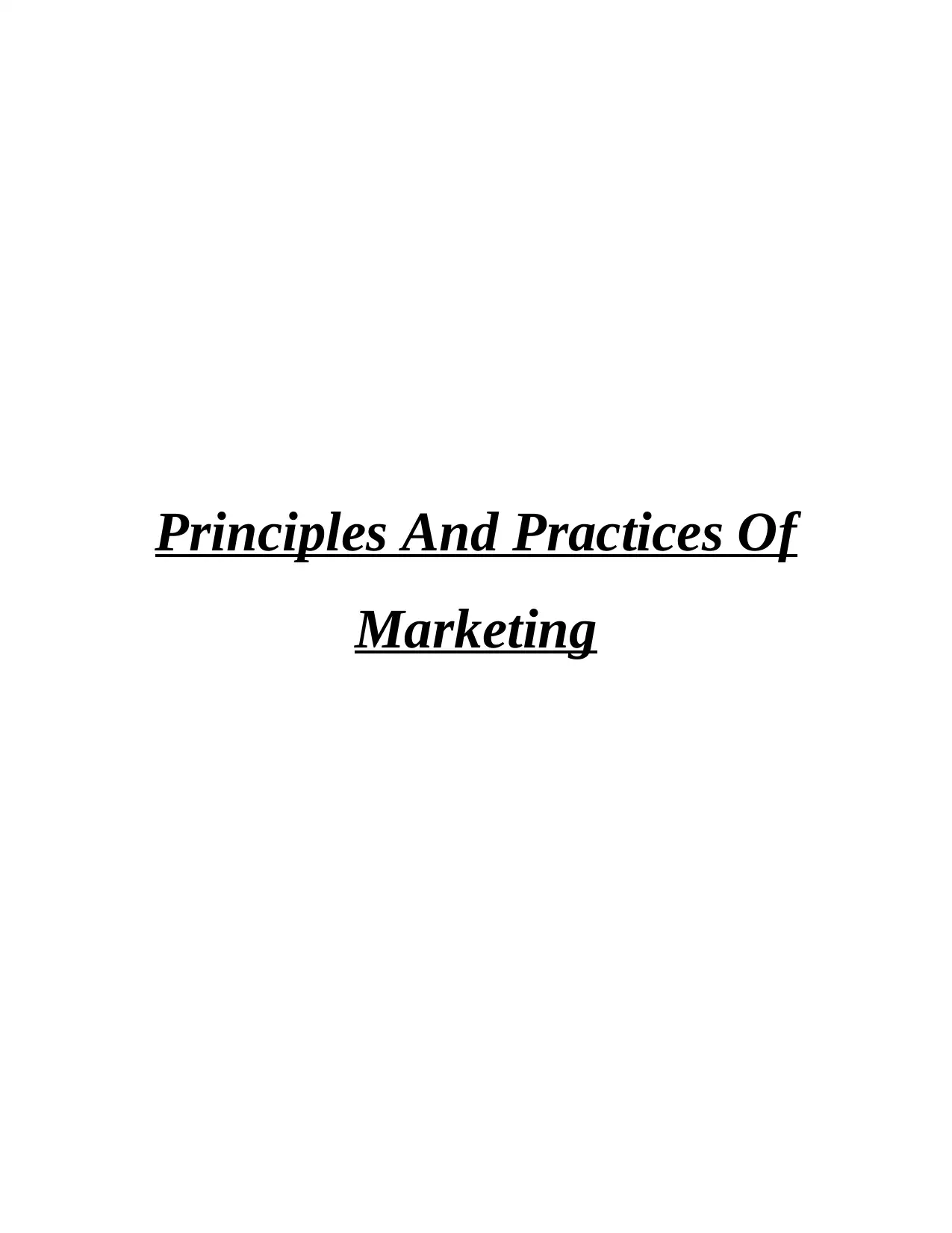
Principles And Practices Of
Marketing
Marketing
Paraphrase This Document
Need a fresh take? Get an instant paraphrase of this document with our AI Paraphraser
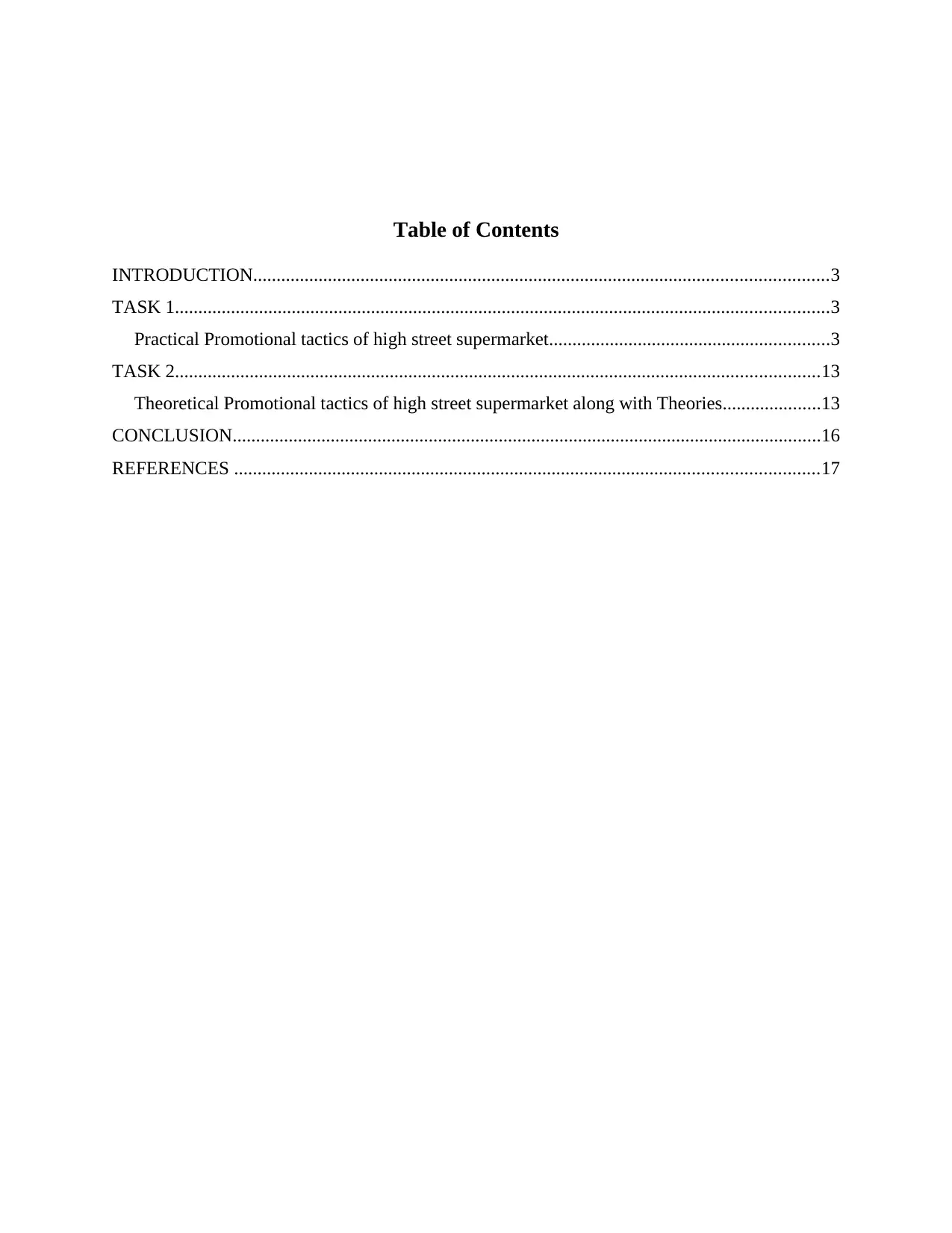
Table of Contents
INTRODUCTION...........................................................................................................................3
TASK 1............................................................................................................................................3
Practical Promotional tactics of high street supermarket............................................................3
TASK 2..........................................................................................................................................13
Theoretical Promotional tactics of high street supermarket along with Theories.....................13
CONCLUSION..............................................................................................................................16
REFERENCES .............................................................................................................................17
INTRODUCTION...........................................................................................................................3
TASK 1............................................................................................................................................3
Practical Promotional tactics of high street supermarket............................................................3
TASK 2..........................................................................................................................................13
Theoretical Promotional tactics of high street supermarket along with Theories.....................13
CONCLUSION..............................................................................................................................16
REFERENCES .............................................................................................................................17
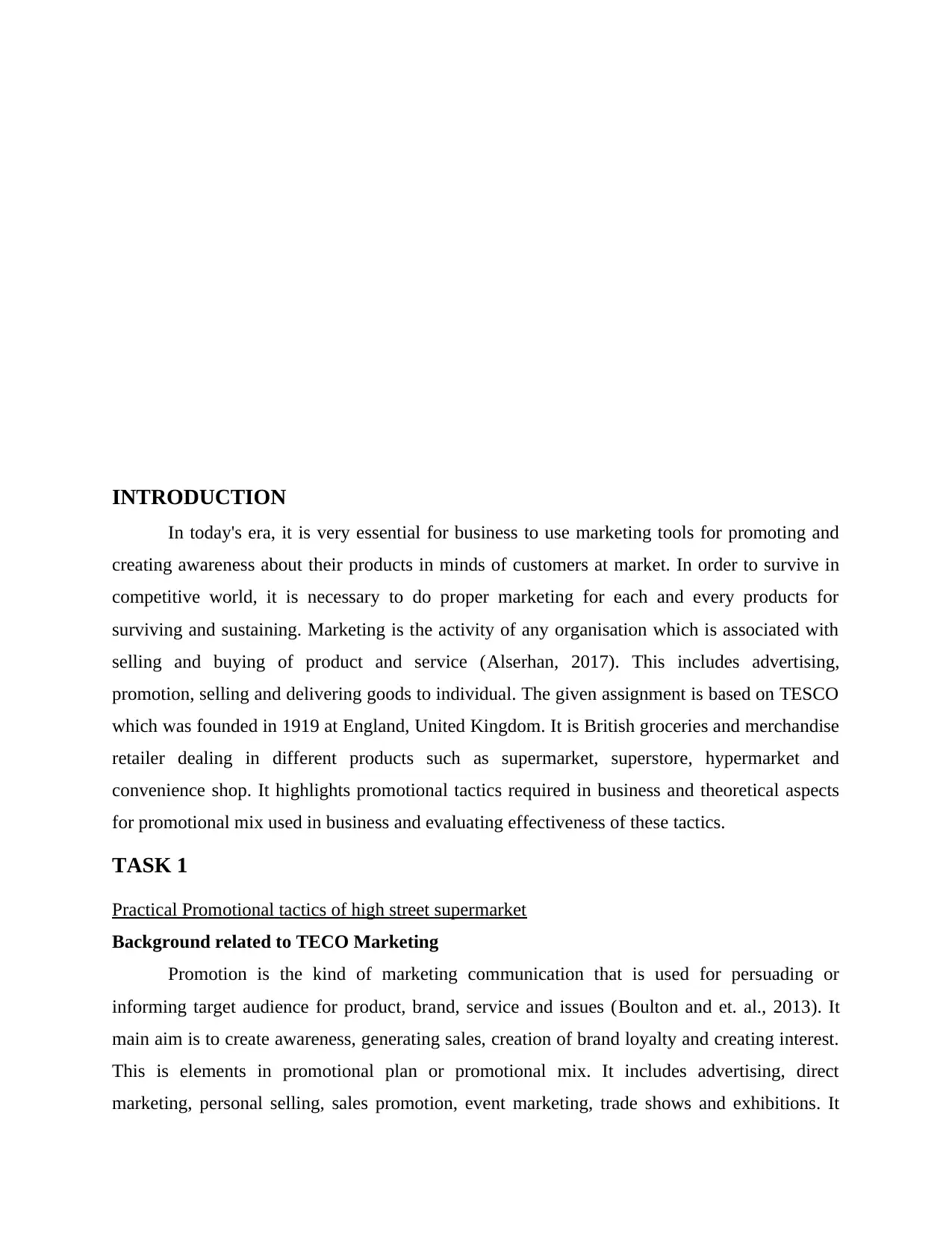
INTRODUCTION
In today's era, it is very essential for business to use marketing tools for promoting and
creating awareness about their products in minds of customers at market. In order to survive in
competitive world, it is necessary to do proper marketing for each and every products for
surviving and sustaining. Marketing is the activity of any organisation which is associated with
selling and buying of product and service (Alserhan, 2017). This includes advertising,
promotion, selling and delivering goods to individual. The given assignment is based on TESCO
which was founded in 1919 at England, United Kingdom. It is British groceries and merchandise
retailer dealing in different products such as supermarket, superstore, hypermarket and
convenience shop. It highlights promotional tactics required in business and theoretical aspects
for promotional mix used in business and evaluating effectiveness of these tactics.
TASK 1
Practical Promotional tactics of high street supermarket
Background related to TECO Marketing
Promotion is the kind of marketing communication that is used for persuading or
informing target audience for product, brand, service and issues (Boulton and et. al., 2013). It
main aim is to create awareness, generating sales, creation of brand loyalty and creating interest.
This is elements in promotional plan or promotional mix. It includes advertising, direct
marketing, personal selling, sales promotion, event marketing, trade shows and exhibitions. It
In today's era, it is very essential for business to use marketing tools for promoting and
creating awareness about their products in minds of customers at market. In order to survive in
competitive world, it is necessary to do proper marketing for each and every products for
surviving and sustaining. Marketing is the activity of any organisation which is associated with
selling and buying of product and service (Alserhan, 2017). This includes advertising,
promotion, selling and delivering goods to individual. The given assignment is based on TESCO
which was founded in 1919 at England, United Kingdom. It is British groceries and merchandise
retailer dealing in different products such as supermarket, superstore, hypermarket and
convenience shop. It highlights promotional tactics required in business and theoretical aspects
for promotional mix used in business and evaluating effectiveness of these tactics.
TASK 1
Practical Promotional tactics of high street supermarket
Background related to TECO Marketing
Promotion is the kind of marketing communication that is used for persuading or
informing target audience for product, brand, service and issues (Boulton and et. al., 2013). It
main aim is to create awareness, generating sales, creation of brand loyalty and creating interest.
This is elements in promotional plan or promotional mix. It includes advertising, direct
marketing, personal selling, sales promotion, event marketing, trade shows and exhibitions. It
⊘ This is a preview!⊘
Do you want full access?
Subscribe today to unlock all pages.

Trusted by 1+ million students worldwide
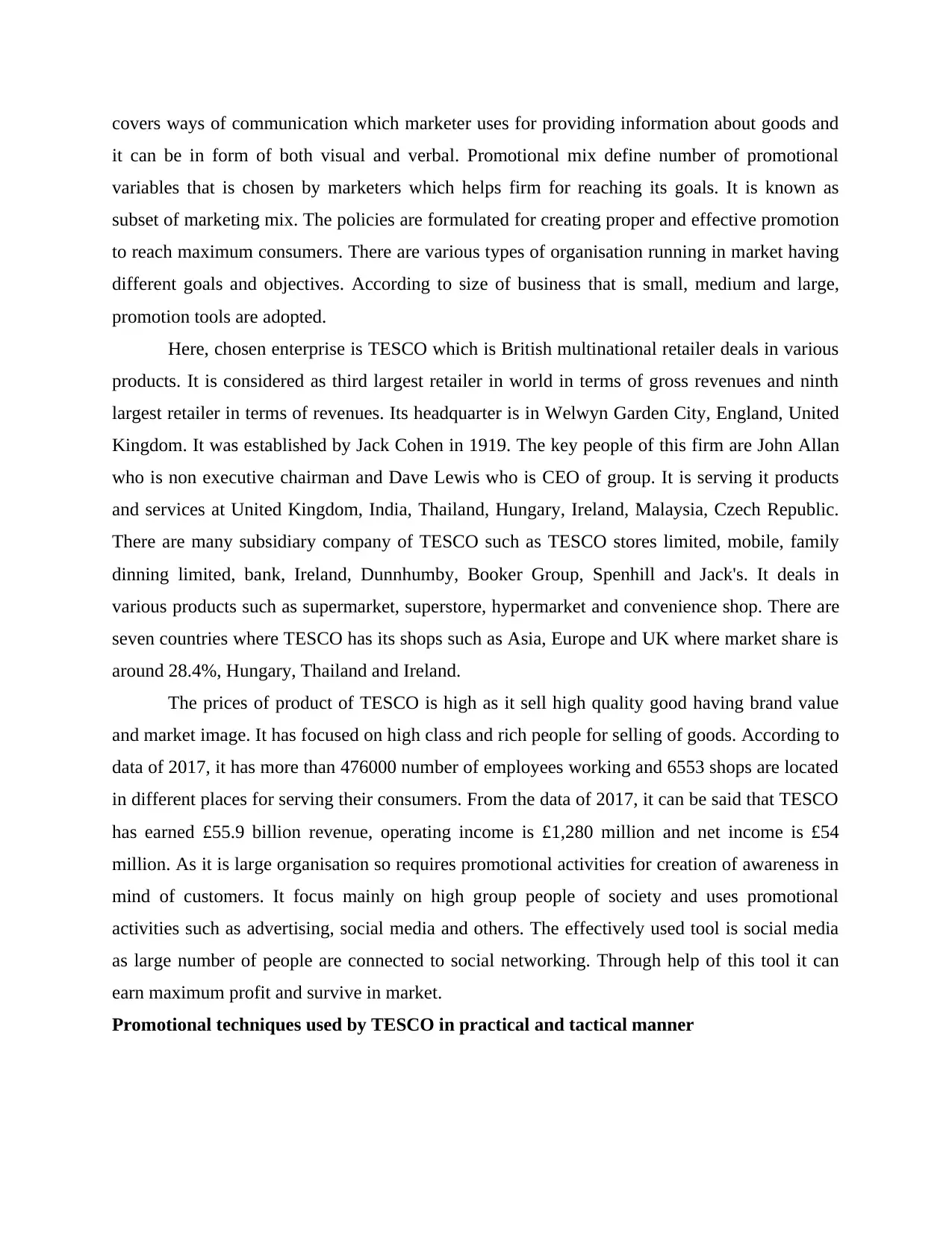
covers ways of communication which marketer uses for providing information about goods and
it can be in form of both visual and verbal. Promotional mix define number of promotional
variables that is chosen by marketers which helps firm for reaching its goals. It is known as
subset of marketing mix. The policies are formulated for creating proper and effective promotion
to reach maximum consumers. There are various types of organisation running in market having
different goals and objectives. According to size of business that is small, medium and large,
promotion tools are adopted.
Here, chosen enterprise is TESCO which is British multinational retailer deals in various
products. It is considered as third largest retailer in world in terms of gross revenues and ninth
largest retailer in terms of revenues. Its headquarter is in Welwyn Garden City, England, United
Kingdom. It was established by Jack Cohen in 1919. The key people of this firm are John Allan
who is non executive chairman and Dave Lewis who is CEO of group. It is serving it products
and services at United Kingdom, India, Thailand, Hungary, Ireland, Malaysia, Czech Republic.
There are many subsidiary company of TESCO such as TESCO stores limited, mobile, family
dinning limited, bank, Ireland, Dunnhumby, Booker Group, Spenhill and Jack's. It deals in
various products such as supermarket, superstore, hypermarket and convenience shop. There are
seven countries where TESCO has its shops such as Asia, Europe and UK where market share is
around 28.4%, Hungary, Thailand and Ireland.
The prices of product of TESCO is high as it sell high quality good having brand value
and market image. It has focused on high class and rich people for selling of goods. According to
data of 2017, it has more than 476000 number of employees working and 6553 shops are located
in different places for serving their consumers. From the data of 2017, it can be said that TESCO
has earned £55.9 billion revenue, operating income is £1,280 million and net income is £54
million. As it is large organisation so requires promotional activities for creation of awareness in
mind of customers. It focus mainly on high group people of society and uses promotional
activities such as advertising, social media and others. The effectively used tool is social media
as large number of people are connected to social networking. Through help of this tool it can
earn maximum profit and survive in market.
Promotional techniques used by TESCO in practical and tactical manner
it can be in form of both visual and verbal. Promotional mix define number of promotional
variables that is chosen by marketers which helps firm for reaching its goals. It is known as
subset of marketing mix. The policies are formulated for creating proper and effective promotion
to reach maximum consumers. There are various types of organisation running in market having
different goals and objectives. According to size of business that is small, medium and large,
promotion tools are adopted.
Here, chosen enterprise is TESCO which is British multinational retailer deals in various
products. It is considered as third largest retailer in world in terms of gross revenues and ninth
largest retailer in terms of revenues. Its headquarter is in Welwyn Garden City, England, United
Kingdom. It was established by Jack Cohen in 1919. The key people of this firm are John Allan
who is non executive chairman and Dave Lewis who is CEO of group. It is serving it products
and services at United Kingdom, India, Thailand, Hungary, Ireland, Malaysia, Czech Republic.
There are many subsidiary company of TESCO such as TESCO stores limited, mobile, family
dinning limited, bank, Ireland, Dunnhumby, Booker Group, Spenhill and Jack's. It deals in
various products such as supermarket, superstore, hypermarket and convenience shop. There are
seven countries where TESCO has its shops such as Asia, Europe and UK where market share is
around 28.4%, Hungary, Thailand and Ireland.
The prices of product of TESCO is high as it sell high quality good having brand value
and market image. It has focused on high class and rich people for selling of goods. According to
data of 2017, it has more than 476000 number of employees working and 6553 shops are located
in different places for serving their consumers. From the data of 2017, it can be said that TESCO
has earned £55.9 billion revenue, operating income is £1,280 million and net income is £54
million. As it is large organisation so requires promotional activities for creation of awareness in
mind of customers. It focus mainly on high group people of society and uses promotional
activities such as advertising, social media and others. The effectively used tool is social media
as large number of people are connected to social networking. Through help of this tool it can
earn maximum profit and survive in market.
Promotional techniques used by TESCO in practical and tactical manner
Paraphrase This Document
Need a fresh take? Get an instant paraphrase of this document with our AI Paraphraser
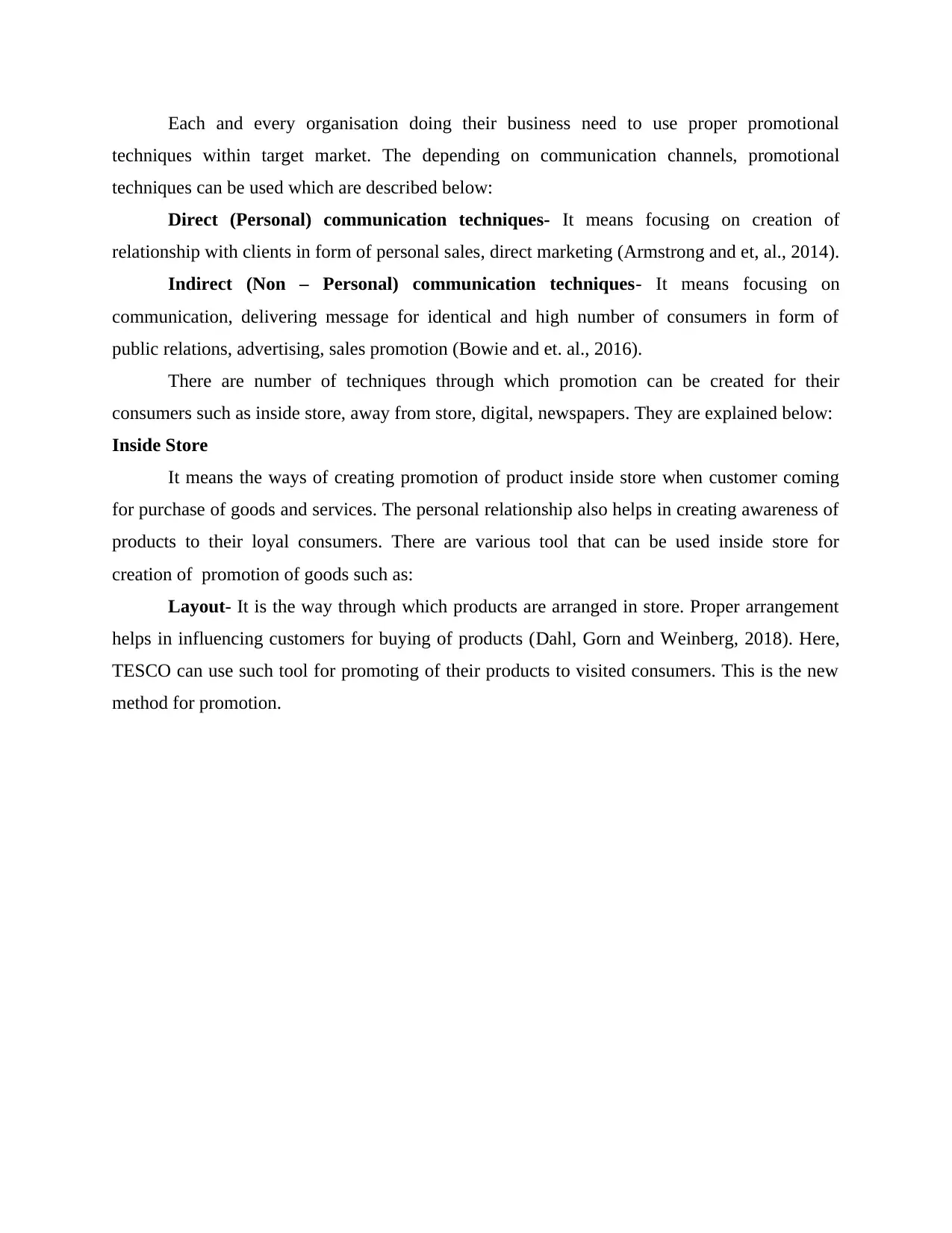
Each and every organisation doing their business need to use proper promotional
techniques within target market. The depending on communication channels, promotional
techniques can be used which are described below:
Direct (Personal) communication techniques- It means focusing on creation of
relationship with clients in form of personal sales, direct marketing (Armstrong and et, al., 2014).
Indirect (Non – Personal) communication techniques- It means focusing on
communication, delivering message for identical and high number of consumers in form of
public relations, advertising, sales promotion (Bowie and et. al., 2016).
There are number of techniques through which promotion can be created for their
consumers such as inside store, away from store, digital, newspapers. They are explained below:
Inside Store
It means the ways of creating promotion of product inside store when customer coming
for purchase of goods and services. The personal relationship also helps in creating awareness of
products to their loyal consumers. There are various tool that can be used inside store for
creation of promotion of goods such as:
Layout- It is the way through which products are arranged in store. Proper arrangement
helps in influencing customers for buying of products (Dahl, Gorn and Weinberg, 2018). Here,
TESCO can use such tool for promoting of their products to visited consumers. This is the new
method for promotion.
techniques within target market. The depending on communication channels, promotional
techniques can be used which are described below:
Direct (Personal) communication techniques- It means focusing on creation of
relationship with clients in form of personal sales, direct marketing (Armstrong and et, al., 2014).
Indirect (Non – Personal) communication techniques- It means focusing on
communication, delivering message for identical and high number of consumers in form of
public relations, advertising, sales promotion (Bowie and et. al., 2016).
There are number of techniques through which promotion can be created for their
consumers such as inside store, away from store, digital, newspapers. They are explained below:
Inside Store
It means the ways of creating promotion of product inside store when customer coming
for purchase of goods and services. The personal relationship also helps in creating awareness of
products to their loyal consumers. There are various tool that can be used inside store for
creation of promotion of goods such as:
Layout- It is the way through which products are arranged in store. Proper arrangement
helps in influencing customers for buying of products (Dahl, Gorn and Weinberg, 2018). Here,
TESCO can use such tool for promoting of their products to visited consumers. This is the new
method for promotion.

(Source: Layout of TESCO)
Service- TESCO can provide various services inside store to their consumers such as
proper sitting arrangement for people, gaming activities for kids, good environment, behaviour
of staff, acceptance of cards, net banking. This influence customers to purchase products and
creates promotion. It also provide self service to customers while buying product as they can
scan their goods through machine and take it.
Illustration 2: Self service of TESCO
(Source: Self service of TESCO)
Illustration 1: Layout of TESCO
Service- TESCO can provide various services inside store to their consumers such as
proper sitting arrangement for people, gaming activities for kids, good environment, behaviour
of staff, acceptance of cards, net banking. This influence customers to purchase products and
creates promotion. It also provide self service to customers while buying product as they can
scan their goods through machine and take it.
Illustration 2: Self service of TESCO
(Source: Self service of TESCO)
Illustration 1: Layout of TESCO
⊘ This is a preview!⊘
Do you want full access?
Subscribe today to unlock all pages.

Trusted by 1+ million students worldwide
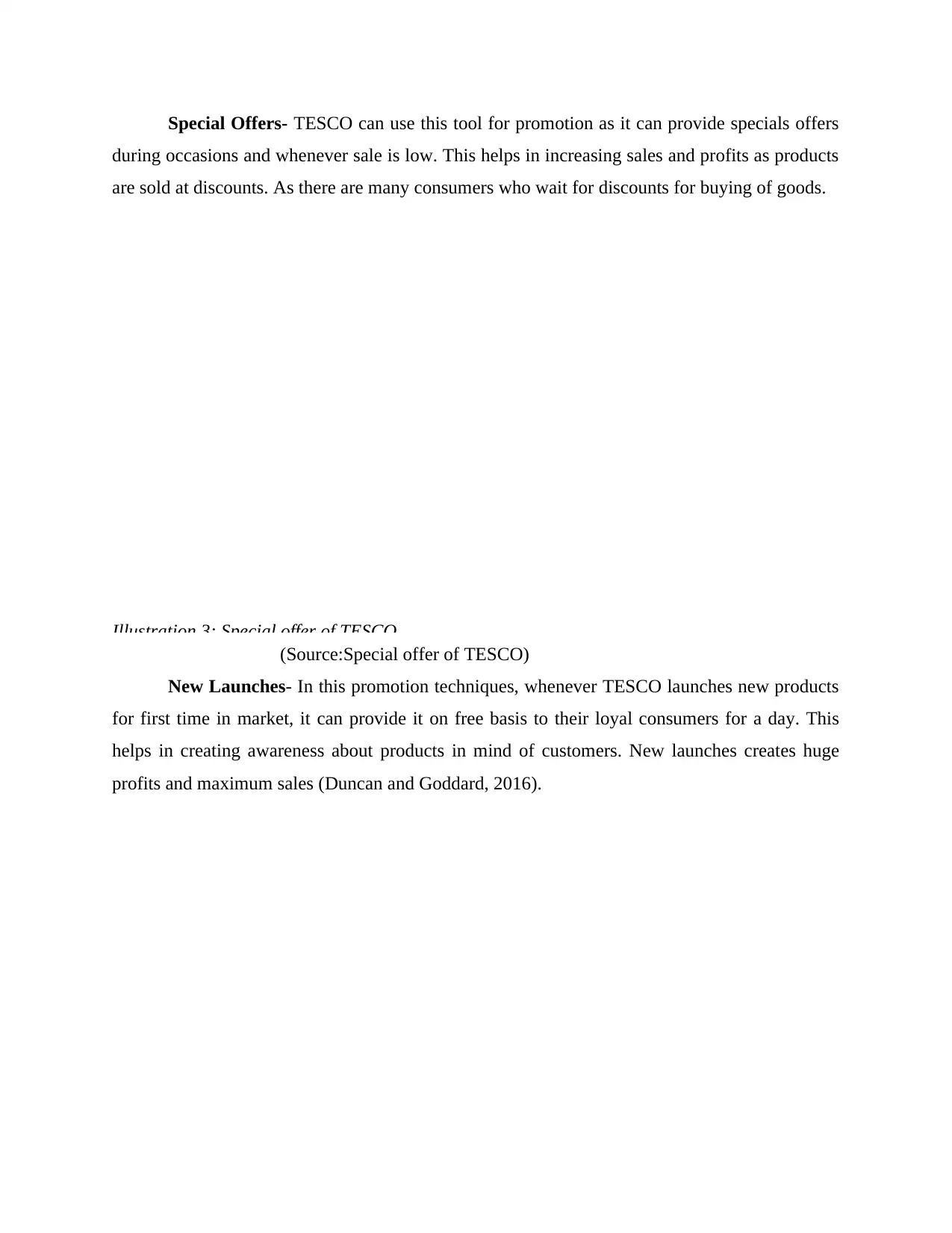
Special Offers- TESCO can use this tool for promotion as it can provide specials offers
during occasions and whenever sale is low. This helps in increasing sales and profits as products
are sold at discounts. As there are many consumers who wait for discounts for buying of goods.
Illustration 3: Special offer of TESCO
(Source:Special offer of TESCO)
New Launches- In this promotion techniques, whenever TESCO launches new products
for first time in market, it can provide it on free basis to their loyal consumers for a day. This
helps in creating awareness about products in mind of customers. New launches creates huge
profits and maximum sales (Duncan and Goddard, 2016).
during occasions and whenever sale is low. This helps in increasing sales and profits as products
are sold at discounts. As there are many consumers who wait for discounts for buying of goods.
Illustration 3: Special offer of TESCO
(Source:Special offer of TESCO)
New Launches- In this promotion techniques, whenever TESCO launches new products
for first time in market, it can provide it on free basis to their loyal consumers for a day. This
helps in creating awareness about products in mind of customers. New launches creates huge
profits and maximum sales (Duncan and Goddard, 2016).
Paraphrase This Document
Need a fresh take? Get an instant paraphrase of this document with our AI Paraphraser
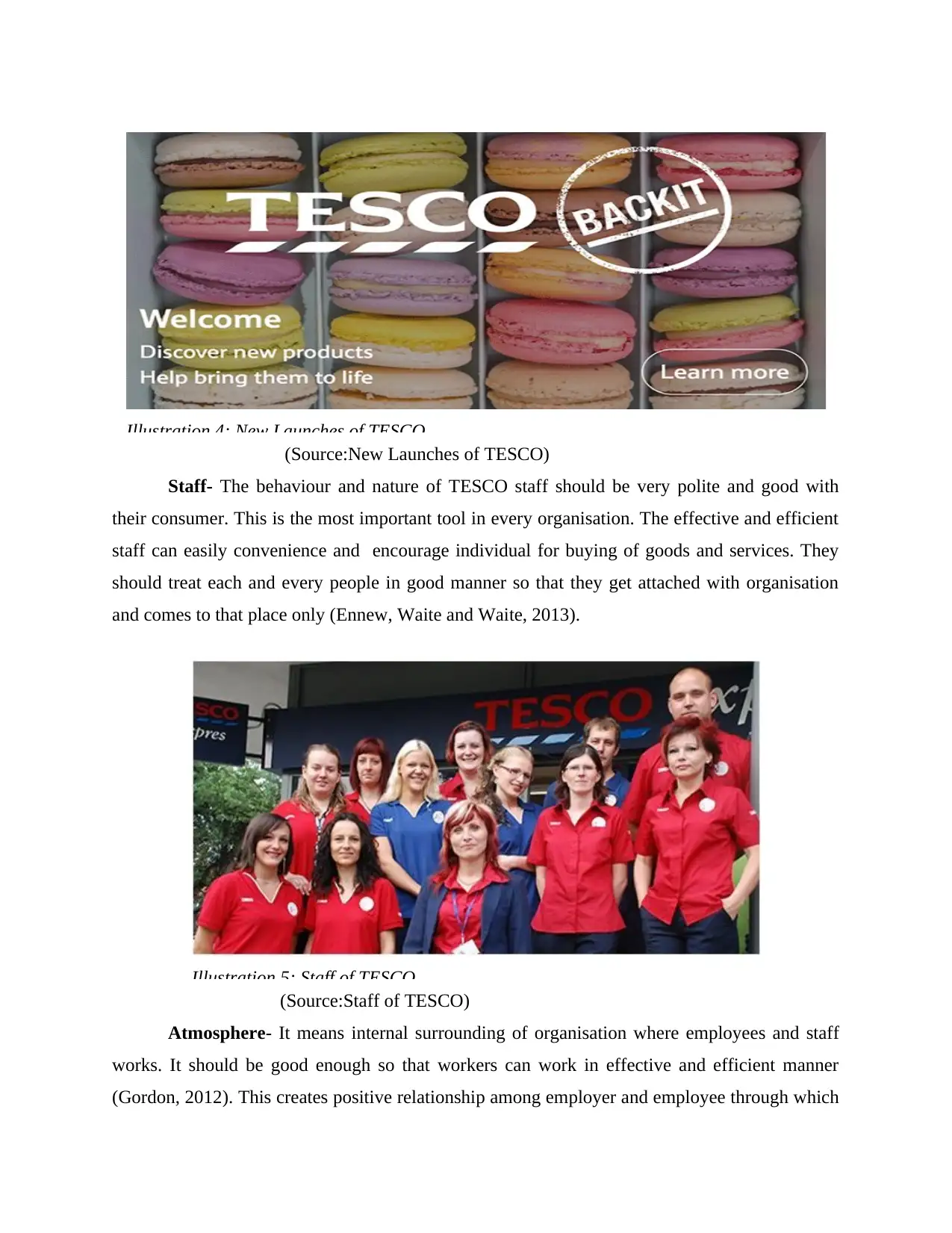
(Source:New Launches of TESCO)
Staff- The behaviour and nature of TESCO staff should be very polite and good with
their consumer. This is the most important tool in every organisation. The effective and efficient
staff can easily convenience and encourage individual for buying of goods and services. They
should treat each and every people in good manner so that they get attached with organisation
and comes to that place only (Ennew, Waite and Waite, 2013).
(Source:Staff of TESCO)
Atmosphere- It means internal surrounding of organisation where employees and staff
works. It should be good enough so that workers can work in effective and efficient manner
(Gordon, 2012). This creates positive relationship among employer and employee through which
Illustration 4: New Launches of TESCO
Illustration 5: Staff of TESCO
Staff- The behaviour and nature of TESCO staff should be very polite and good with
their consumer. This is the most important tool in every organisation. The effective and efficient
staff can easily convenience and encourage individual for buying of goods and services. They
should treat each and every people in good manner so that they get attached with organisation
and comes to that place only (Ennew, Waite and Waite, 2013).
(Source:Staff of TESCO)
Atmosphere- It means internal surrounding of organisation where employees and staff
works. It should be good enough so that workers can work in effective and efficient manner
(Gordon, 2012). This creates positive relationship among employer and employee through which
Illustration 4: New Launches of TESCO
Illustration 5: Staff of TESCO

they can serve their consumer in better way. Atmosphere should be positive and they should get
opportunity to learn new things, provide training and development for improving themselves.
Thus, this is the most attractive and innovation ways of creating promotion at TESCO.
Porter Generic Model
There are two approaches in this model such as cost leadership and differentiation
strategy. Here, TESCO has used cost leadership strategy where profit increases by reducing cost
and increment in market share by charging low prices. It is the strategy where organisation need
to lower cost in order to increase profits and market share in competitive market. This helps in
achieving set goals and objectives. This can be done if business has lower cost in technology,
efficient logistics and low cost labour. They need to provide high quality and continuous
improvement need to be done on regular basis. For example, if consumer get high quality goods
at low price with all benefits then obviously they prefer to purchase from that outlet or shops.
There are many competitors of TESCO such as Sainsbury's, ALDI, Marks and Spencer. In order
to compete with them, price for products should be lower.
Customer Relationship Management (CRM)
It is an approach used for managing company's interaction with potential and current
consumers (Lawless and Heymann, 2013). This need to use data analysis about customer's
history in an organisation for improving relationship with their consumers and focusing on
retention of their potential and increasing sales growth. There are mainly three types of CRM
which are described below:
Operational CRM- It helps in generating leads, converting them into contacts, capturing
relevant information and providing service through user life cycle. This CRM is used mainly in
marketing automation, service automation and sales automation.
Analytical CRM- This helps to top administration, sales, marketing and supporting
individuals for better serving to consumers and making proper decisions in organisation.
Collaborative CRM- It is also known as strategic CRM, that enables enterprise for
sharing information of consumers in business sections such as marketing team, support team,
sales team and technical team. This helps in uniting all groups into one and using information for
improving quality of customer service for gaining loyalty and acquiring new people for sales
increment.
opportunity to learn new things, provide training and development for improving themselves.
Thus, this is the most attractive and innovation ways of creating promotion at TESCO.
Porter Generic Model
There are two approaches in this model such as cost leadership and differentiation
strategy. Here, TESCO has used cost leadership strategy where profit increases by reducing cost
and increment in market share by charging low prices. It is the strategy where organisation need
to lower cost in order to increase profits and market share in competitive market. This helps in
achieving set goals and objectives. This can be done if business has lower cost in technology,
efficient logistics and low cost labour. They need to provide high quality and continuous
improvement need to be done on regular basis. For example, if consumer get high quality goods
at low price with all benefits then obviously they prefer to purchase from that outlet or shops.
There are many competitors of TESCO such as Sainsbury's, ALDI, Marks and Spencer. In order
to compete with them, price for products should be lower.
Customer Relationship Management (CRM)
It is an approach used for managing company's interaction with potential and current
consumers (Lawless and Heymann, 2013). This need to use data analysis about customer's
history in an organisation for improving relationship with their consumers and focusing on
retention of their potential and increasing sales growth. There are mainly three types of CRM
which are described below:
Operational CRM- It helps in generating leads, converting them into contacts, capturing
relevant information and providing service through user life cycle. This CRM is used mainly in
marketing automation, service automation and sales automation.
Analytical CRM- This helps to top administration, sales, marketing and supporting
individuals for better serving to consumers and making proper decisions in organisation.
Collaborative CRM- It is also known as strategic CRM, that enables enterprise for
sharing information of consumers in business sections such as marketing team, support team,
sales team and technical team. This helps in uniting all groups into one and using information for
improving quality of customer service for gaining loyalty and acquiring new people for sales
increment.
⊘ This is a preview!⊘
Do you want full access?
Subscribe today to unlock all pages.

Trusted by 1+ million students worldwide
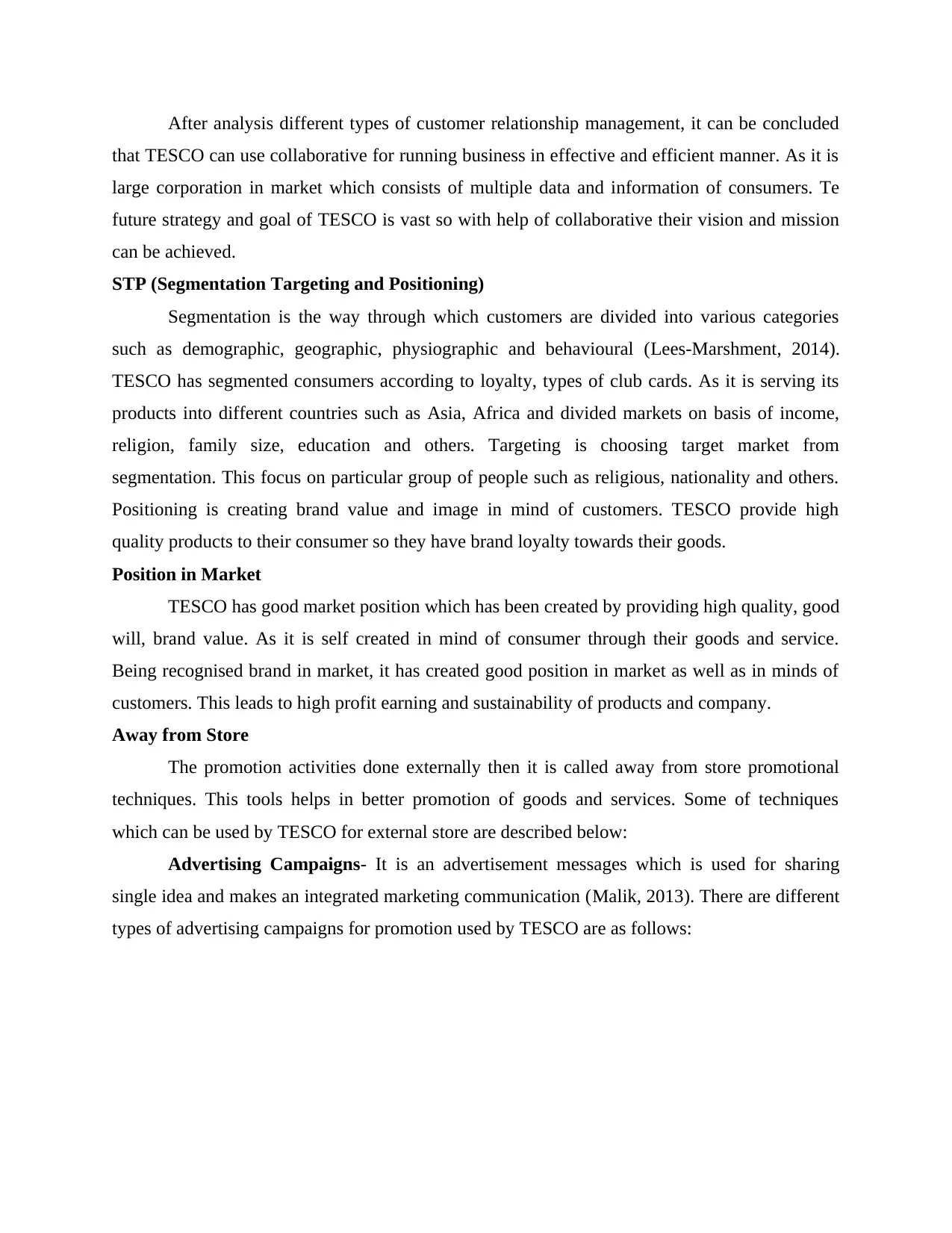
After analysis different types of customer relationship management, it can be concluded
that TESCO can use collaborative for running business in effective and efficient manner. As it is
large corporation in market which consists of multiple data and information of consumers. Te
future strategy and goal of TESCO is vast so with help of collaborative their vision and mission
can be achieved.
STP (Segmentation Targeting and Positioning)
Segmentation is the way through which customers are divided into various categories
such as demographic, geographic, physiographic and behavioural (Lees-Marshment, 2014).
TESCO has segmented consumers according to loyalty, types of club cards. As it is serving its
products into different countries such as Asia, Africa and divided markets on basis of income,
religion, family size, education and others. Targeting is choosing target market from
segmentation. This focus on particular group of people such as religious, nationality and others.
Positioning is creating brand value and image in mind of customers. TESCO provide high
quality products to their consumer so they have brand loyalty towards their goods.
Position in Market
TESCO has good market position which has been created by providing high quality, good
will, brand value. As it is self created in mind of consumer through their goods and service.
Being recognised brand in market, it has created good position in market as well as in minds of
customers. This leads to high profit earning and sustainability of products and company.
Away from Store
The promotion activities done externally then it is called away from store promotional
techniques. This tools helps in better promotion of goods and services. Some of techniques
which can be used by TESCO for external store are described below:
Advertising Campaigns- It is an advertisement messages which is used for sharing
single idea and makes an integrated marketing communication (Malik, 2013). There are different
types of advertising campaigns for promotion used by TESCO are as follows:
that TESCO can use collaborative for running business in effective and efficient manner. As it is
large corporation in market which consists of multiple data and information of consumers. Te
future strategy and goal of TESCO is vast so with help of collaborative their vision and mission
can be achieved.
STP (Segmentation Targeting and Positioning)
Segmentation is the way through which customers are divided into various categories
such as demographic, geographic, physiographic and behavioural (Lees-Marshment, 2014).
TESCO has segmented consumers according to loyalty, types of club cards. As it is serving its
products into different countries such as Asia, Africa and divided markets on basis of income,
religion, family size, education and others. Targeting is choosing target market from
segmentation. This focus on particular group of people such as religious, nationality and others.
Positioning is creating brand value and image in mind of customers. TESCO provide high
quality products to their consumer so they have brand loyalty towards their goods.
Position in Market
TESCO has good market position which has been created by providing high quality, good
will, brand value. As it is self created in mind of consumer through their goods and service.
Being recognised brand in market, it has created good position in market as well as in minds of
customers. This leads to high profit earning and sustainability of products and company.
Away from Store
The promotion activities done externally then it is called away from store promotional
techniques. This tools helps in better promotion of goods and services. Some of techniques
which can be used by TESCO for external store are described below:
Advertising Campaigns- It is an advertisement messages which is used for sharing
single idea and makes an integrated marketing communication (Malik, 2013). There are different
types of advertising campaigns for promotion used by TESCO are as follows:
Paraphrase This Document
Need a fresh take? Get an instant paraphrase of this document with our AI Paraphraser
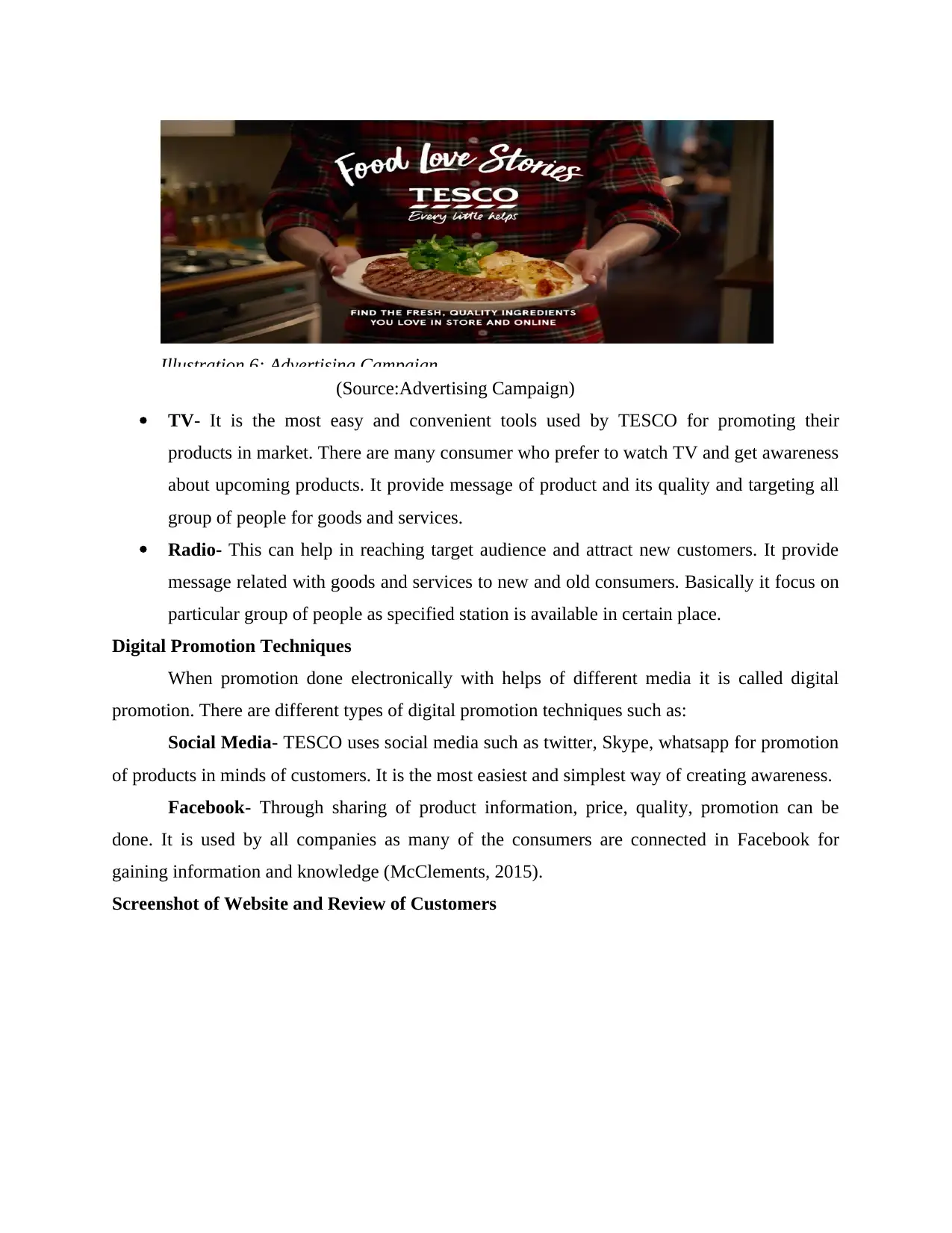
(Source:Advertising Campaign)
TV- It is the most easy and convenient tools used by TESCO for promoting their
products in market. There are many consumer who prefer to watch TV and get awareness
about upcoming products. It provide message of product and its quality and targeting all
group of people for goods and services.
Radio- This can help in reaching target audience and attract new customers. It provide
message related with goods and services to new and old consumers. Basically it focus on
particular group of people as specified station is available in certain place.
Digital Promotion Techniques
When promotion done electronically with helps of different media it is called digital
promotion. There are different types of digital promotion techniques such as:
Social Media- TESCO uses social media such as twitter, Skype, whatsapp for promotion
of products in minds of customers. It is the most easiest and simplest way of creating awareness.
Facebook- Through sharing of product information, price, quality, promotion can be
done. It is used by all companies as many of the consumers are connected in Facebook for
gaining information and knowledge (McClements, 2015).
Screenshot of Website and Review of Customers
Illustration 6: Advertising Campaign
TV- It is the most easy and convenient tools used by TESCO for promoting their
products in market. There are many consumer who prefer to watch TV and get awareness
about upcoming products. It provide message of product and its quality and targeting all
group of people for goods and services.
Radio- This can help in reaching target audience and attract new customers. It provide
message related with goods and services to new and old consumers. Basically it focus on
particular group of people as specified station is available in certain place.
Digital Promotion Techniques
When promotion done electronically with helps of different media it is called digital
promotion. There are different types of digital promotion techniques such as:
Social Media- TESCO uses social media such as twitter, Skype, whatsapp for promotion
of products in minds of customers. It is the most easiest and simplest way of creating awareness.
Facebook- Through sharing of product information, price, quality, promotion can be
done. It is used by all companies as many of the consumers are connected in Facebook for
gaining information and knowledge (McClements, 2015).
Screenshot of Website and Review of Customers
Illustration 6: Advertising Campaign
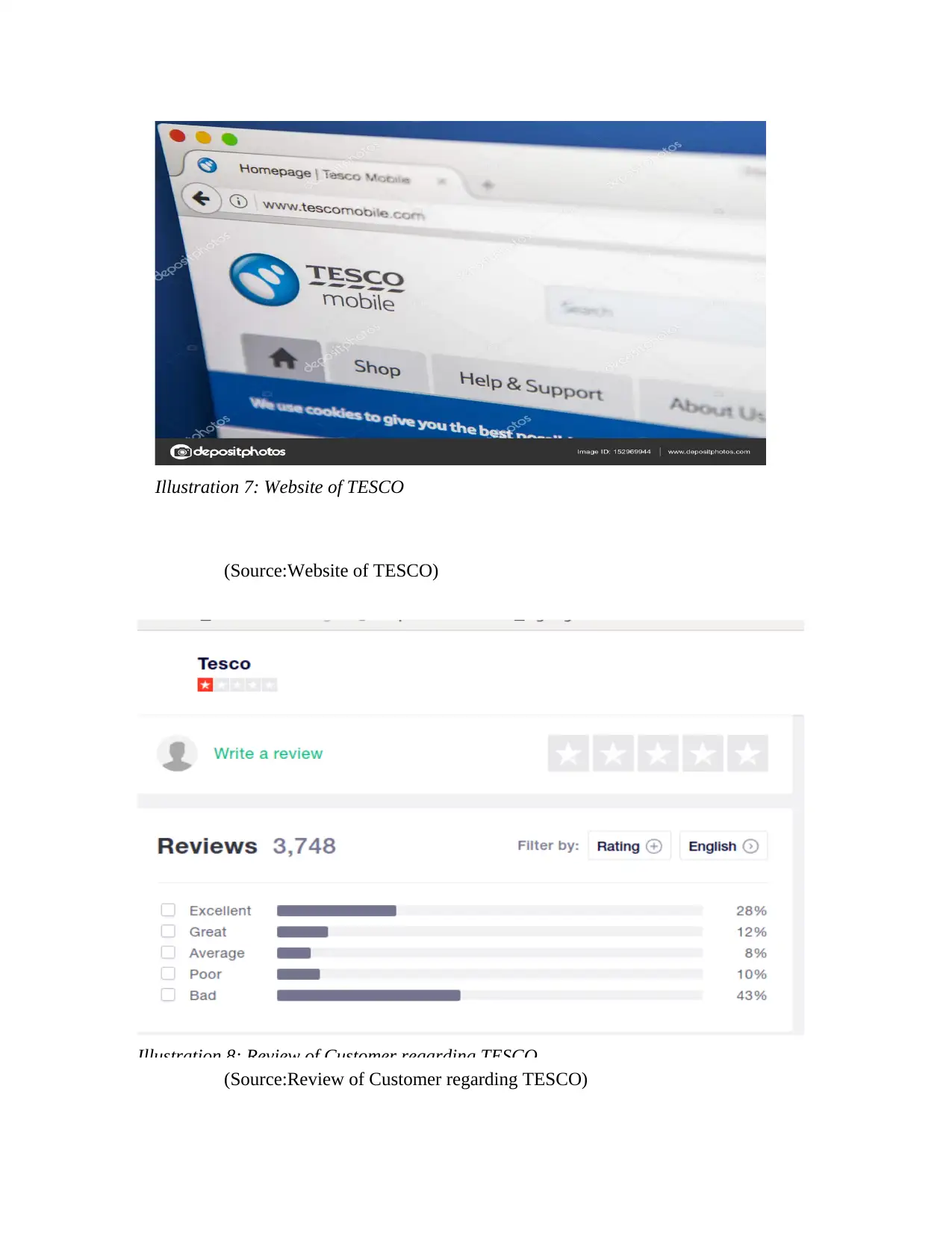
(Source:Website of TESCO)
(Source:Review of Customer regarding TESCO)
Illustration 7: Website of TESCO
Illustration 8: Review of Customer regarding TESCO
(Source:Review of Customer regarding TESCO)
Illustration 7: Website of TESCO
Illustration 8: Review of Customer regarding TESCO
⊘ This is a preview!⊘
Do you want full access?
Subscribe today to unlock all pages.

Trusted by 1+ million students worldwide
1 out of 18
Related Documents
Your All-in-One AI-Powered Toolkit for Academic Success.
+13062052269
info@desklib.com
Available 24*7 on WhatsApp / Email
![[object Object]](/_next/static/media/star-bottom.7253800d.svg)
Unlock your academic potential
Copyright © 2020–2025 A2Z Services. All Rights Reserved. Developed and managed by ZUCOL.





